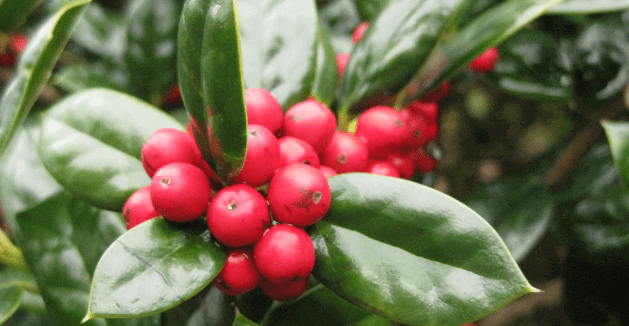Using Holly In Landscaping
In addition to using Holly in landscaping, they have been used for holiday decorating for centuries. They are mentioned in the Christmas song “Deck The Halls” and “Have A Holly Jolly Christmas”. Christians consider Holly symbolic of thorns worn by Jesus when He died on the cross. Before holly was hung in houses to accompany Christmas Trees, it was considered to be a sacred plant by the Druids, as a symbol of fertility and eternal life. Using Holly in landscaping is mainly done for their rich evergreen foliage and showy red berries. Most “proper” southern landscapes will sport a holly hedge or a single specimen to create year round interest.
Three Great Varieties
- Nellie R Stevens is the favorite large scale Holly to use. Growing to a height of 15′ – 25′ feet & 5′ – 10′ wide, this Holly is not suited for foundation purposes. Planted out in the yard, it makes a wonderful privacy screen. It is also especially pretty during the Winter months. Cut some for holiday decorating or just enjoy the birds who will also find the winter berries attractive. Nellie R Stevens is a female holly, but you don’t have to purchase a male holly to pollinate it. There are plenty of Hollies that bloom at the same time, and can act as a pollinator. It is a Chinese Holly, so the large glossy leaves do have spines on the edges. If you plant a Nellie with the proper spacing for it’s size and maturity, you should not have to prune it & tangle with these spiny leaves!
- On a smaller scale, Needlepoint Holly grows 8′ high X 6′ wide. It makes a wonderful hedge when planted in masses. Another broadleaf Chinese type, it only has one spine at the tip of the leaf. You can expect Needlepoint to be loaded with red berries for Winter interest.
- Dwarf Burford Holly is another Chinese Holly but is smaller @ 6′ x 5′ maturation and with significantly less fruit than Needlepoint. It makes a great hedge in the 4′ – 6′ range.
Tree Form Hollies
When using Holly in landscaping, there are also some tree form varieties. The native American Holly grows large and also has berries in the Winter. A slow grower, it’s evergreen foliage is dull green, lacking the waxy look of Chinese Hollies. They are hard to find in retail nurseries, but can be seen when hiking in the mountains of East Tennessee. Foster’s Holly is another good tree variety with finer leaves than the American but is really show in the Winter with berries, a favorite of the birds.
Take a good look at your yard this Winter. I’m sure You’ll find a bad view that you’d like to screen off or simply a bare spot that needs a jewel of a plant. Think Holly, by golly! You may plant all winter long in East Tennessee by the way. See ya soon??

